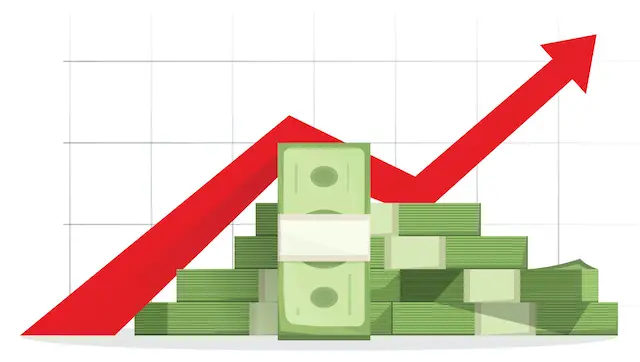In November, the S&P 500 index went up 3.4%. This is the benchmark index for the C Fund in the Thrift Savings Plan (TSP). The Dow-Jones Industrial Average is another widely followed stock index and it was up 3.7% during the month.
The November returns in the stock market are the biggest monthly gains for these indices since June.
The stock market is now getting closer to having its largest yearly gain since 2013. In part, the continuing rise in the stock market is due to a change in monetary policy earlier in the year and what appears to be some progress in the U.S. and China’s trade negotiations.
TSP Returns
The TSP stock funds also had another good monthly return in November.
The S Fund finished on top with a return of 4.54%. It is up 25.27% for the year-to-date. The C Fund was not quite as good and had a return of 3.63%.
The C Fund is up 27.61% for the year-to-date which is the best return for any TSP fund in 2019. At the end of December, if the C Fund holds up, it would be the best year for C Fund returns since 2003. In 2003, the C Fund had a return of 28.54%.
The C Fund is also up 16.09% for the past twelve months. This is also the fund with the highest return for the past 12 months. While no one knows what will happen in December in the stock market, the 12-month return for the C Fund is likely to jump up as the C Fund lost 9.03% last December.
Here is how the funds in the Thrift Savings Plan have fared for the past month, the year-to-date and for the past 12 months.
|
| G Fund | F Fund | C Fund | S Fund | I Fund |
| Month | 0.14% | -0.05% | 3.63% | 4.54% | 1.15% |
| YTD | 2.08% | 8.76% | 27.61% | 25.27% | 18.63% |
| 12 Month | 2.34% | 10.76% | 16.09% | 11.87% | 12.91% |
|
| L Income | L 2020 | L 2030 | L 2040 | L 2050 |
| Month | 0.71% | 0.83% | 1.77% | 2.10% | 2.38% |
| YTD | 6.81% | 8.44% | 15.49% | 18.14% | 20.41% |
| 12 Month | 5.40% | 6.08% | 10.13% | 11.52% | 12.64% |
Actions by TSP Investors in November
In November, TSP investors added about $308 million to the G Fund with interfund transfers and another $119 million to the F Fund.
For the TSP stock funds, TSP investors transferred about $639 million out of the S Fund and about $82 million out of the C Fund. $88 million was added to the I Fund and $204 million to the Lifecycle Funds.
The amount of these transfers was substantially less than the previous month. In October, for comparison purposes, more than $1.9 billion was transferred into the G Fund while $836 million was transferred out of the C Fund and $999 million was moved from the S Fund.
Comparing Allocation of TSP Funds
Investors modify their investments over time based on a number of factors. These factors may include preparing for retirement, a change in their belief on how the stock market will perform in the coming months, international or political events that may impact a change in the investment climate or any number of personal events.
Comparing how investors had allocated their money in the TSP funds as of November 30, 2018, and November 30, 2019, there have been some minor adjustments but no major changes.
There has been a slight decrease in the percentage of investments in the G Fund and a slight increase in F Fund investment. C Fund investments are still very close as of the end of November compared to one year ago with a decrease from 28.9% to 28.7%.
There has been a larger change in S Fund investments with 9.5% of TSP assets now in the S Fund compared to 10.3% last year at the same time. There is also a larger percentage now in the Lifecycle Funds (21.3%) compared to 20.5% in 2018.
| Fund | % of Investments 11/30/2018 | % of Investments 11/30/2019 |
| G Fund | 32.5% | 32.2% |
| F Fund | 3.5% | 4.0% |
| C Fund | 28.9% | 28.7% |
| S Fund | 10.3% | 9.5% |
| I Fund | 4.3% | 4.2% |
| L Funds | 20.5% | 21.3% |
| Total | 100% | 100% |
TSP investors have enjoyed a banner year with their investment in the TSP stock funds. Congratulations to anyone investing in these funds. For those who have not been long term investors in the stock market, keep this in mind.
By conventional measures, the current bull market started in March 2009. That is when the S&P 500 index bottomed out after the global financial crisis. This means the bull market in stocks that we have been enjoying is more than 10.5 years old. This is a record as the longest bull market in history. The average bull market lasts about 4.5 years.
That does not mean the current bull market is about to end. It does mean that diversifying your investments makes sense because, when the market does turn negative (note this is when the market turns, not if it will ever turn down again), it could be a big drop just because the stock market’s rise has been so long-lasting.
Congratulations to readers who are enjoying these excellent returns in stocks this year!



